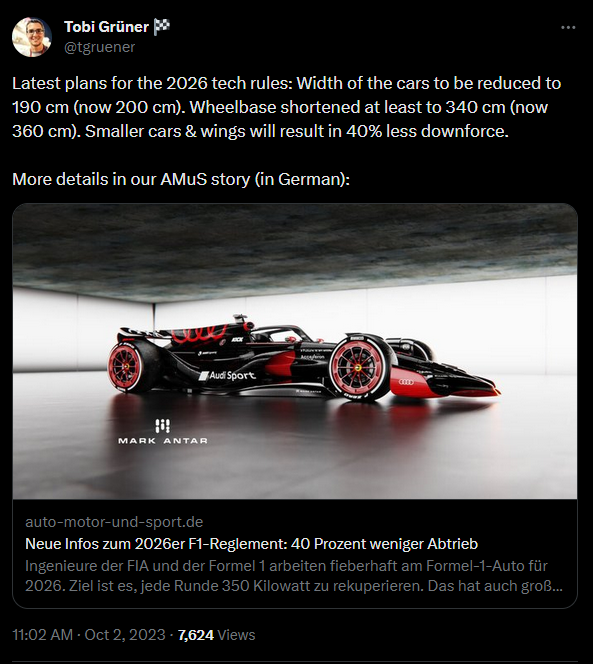Smaller cars & wings will result in 40% less downforce.
Translation:
Two years is not a lot of time when you're working on new Formula One regulations. And the changes for 2026 will be even bigger than those for 2022, because they will affect both the powertrain and the car. The new engine rules will help determine what the car will look like. That's because the powertrain concept is changing in a big way.
The rules for the hybrid drive are largely known. The architecture of the combustion engine will not change much. The minimum weight is set at 130 kilograms, that of the turbocharger at 12 kilograms. The MGU-K must weigh at least 16 kilograms, the battery 35 kilograms. This would result in a total weight of 193 kilograms, 23 percent more than at present.
In addition to using 100 percent sustainable fuel, the share of electric power is almost tripled. 350 instead of 120 kilowatts will then come from the battery. However, only the MGU-K is still available for the recuperation of 475 hp. The MGU-H, which draws energy from the excess energy of the exhaust gases, is omitted.
20 kilos lighter is realistic
This has an impact on the rest of the car. Somehow the battery has to be reliably supplied with energy every lap. The classic recuperation of kinetic energy in the engine's partial load range is not enough. In addition, gasoline must be consumed to generate electrical power. Experts assume that of the 100 kilograms of gasoline that will be available for the race, around 30 kilograms will be used to charge the battery.
The high weight of the new generation of drive units is another problem. The current cars, weighing 798 kilograms, are already far too heavy for purists. With the extra weight for the new hybrid drive system, it would rise well above 800 kilograms without countermeasures.
However, the FIA recently announced its intention to reduce the total weight of the cars by 50 kilograms. Formula 1 Technical Director Pat Symonds considers this figure to be very optimistic, but sees a good chance of reducing the weight by at least 20 kilograms in a first step.
Will the minimum weight be abandoned?
There may no longer be a minimum weight at all. Competition would bring the weight down the fastest. There are sympathizers for this in both the FIA and Formula 1. The FIA's strict load tests on the one hand and the budget cap on the other would prevent safety-related excesses and an explosion in costs.
The technical offices would then have to decide how much money to invest in guaranteed lap time (weight) or theoretical (aerodynamics). The 2022 season showed that this balancing act can be quite appealing. Alfa Romeo had done disproportionately well thanks to a lightweight car, while Red Bull had done worse than its excellent aerodynamics would actually have promised because of the extra weight.
However, FIA sports chief Nikolas Tombazis and Pat Symonds still have concerns that some teams might push it too far with the suspensions. To rule out risk, minimum standards would have to be introduced. As a first step, however, it would be conceivable to lift the weight limit for the drive components. Here, too, a cost cap would protect against an expensive arms race. The only risk with too much lightweight construction would be defects, but a bit more unpredictability would do the sport good.
Wheelbase shrinks by at least 20 centimeters
Either way, the powertrain will be heavier than it is today, even without a minimum weight. That has to be made up in the rest of the car. And that's where the red pencil is being applied everywhere. The transmission will have only six gears instead of eight. The cars and tires will be smaller. The width is to shrink from 200 to 190 centimeters, the wheelbase from the current 360 to 340 centimeters. Symonds even considers 330 centimeters possible, but is encountering resistance from some teams.
The reduction in area and volume also affects the wings. Experts have calculated that downforce will be reduced by 40 percent. Active aerodynamics should further reduce drag on the straights so that the cars do not have to sail for too long to charge the battery. Simulations have shown that when all factors are factored in, the cars will still be barely slower.
The good news is that overtaking should become easier without artificial aids. The engineers are planning a small concept change for this, which was already discussed for the 2022 cars but then put on the back burner. Symonds doesn't want to reveal what it involves yet. Only this much: In the future, it will be much easier to follow another car.

They were pretty close to it in the 1980s.
https://i.redd.it/eb7tp8r27v721.jpg